Entrepreneur's Hall of Fame: Edwin Land
|
Quotes "Either you believe that this kind of individual greatness does exist and can be nurtured and developed, that such great individuals can be part of a cooperative community while they continue to be their happy, flourishing, contributing selves -- or else you believe that there is some mystical, cyclical, overriding, predetermined cultural law -- a historic determinism." --MIT, 22 May 1957.
"All of our confidence has to come from making things... Let us not make more of something there is too much of. Let us find out what is desperately needed, although people may not know it. Let us find out what will beautify the world, although people may not know it. Then let's learn and learn and teach ourselves, and support each other in doing that until we lose ourselves in those tasks." -- 5 February 1960. "The only thing that is keeping us alive is our brilliance. The only way to protect our brilliance is patents." -- 27 April 1976. " There's a rule they don't teach you at Harvard Business School. It is: If anything is worth doing, it's worth doing to excess." -- 26 April 1977. "The only thing that matters is the bottom line?' What a presumptuous thing to say. The bottom line's in heaven. The real business of business is building things." -- 26 April 1977. "You always start with a fantasy. Part of the fantasy technique is to visualize something as perfect. Then with the experiments you work back from the fantasy to reality, hacking away at the components." -- 1978. Entrepreneurship at an early age In the daytime as a boy, Land loved to visit his local library, not just for the books but also to use a kaleidoscope and a stereopticon that could produce wonderful three-dimensional views of grottoes. At night, he avidly read a textbook on optics by Robert W. Wood of Johns Hopkins, who had studied with Henry Rowland, one of America's leading scientists of the 19th century. When 13-year-old Land went to a summer camp near his home in New London, Connecticut, his teacher fascinated him by suppressing the glare of light from a table top with a crystal of light-polarizing glass. Just four years later, after a few disappointing months as a Harvard freshman, Land headed to New York to get going on polarizer experiments. He alternated between the great reading room of the New York Public Library, a succession of basement labs in Manhattan, and occasional surreptitious night visits to the delicate instruments of a physics lab at Columbia University. While in New York, he was inspired by the idea that sheets of polarizing plastic on headlights and windshields could abolish nighttime highway glare. He tried to make big thin sheets of polarizing iodine
compounds, but failed. So he turned in the opposite
direction, and tried making submicroscopic crystals
by the billions. These could be spread on plastic
sheets and lined up by electric or magnetic fields,
or by stretching the sheet. Two such sheets could
be rotated with respect to each other, so that a clear
view could gradually change to black. Land's father
helped with a $5,000 loan. In September 1928, Land's
lawyer, Julius Silver, who had been his camp counselor,
took him to Donald Brown, who became Land's patent
lawyer for nearly 40 years. A little more than four
years later, in 1933, Land received the first of 535
patents (a total second only to Edison's) after a
fierce struggle with rival inventors. By then, Land had married and spent three more years as a Harvard undergraduate -- with his own special lab in the physics building -- and then quit without a degree to start his own business in partnership with George Wheelwright, who had been one of his physics instructors at Harvard and provided mot of the money. Land and Wheelwright aimed at making polarizers, of the material that came to be known as polaroid, for three-dimension movie-viewing spectacles and for stopping headlight glare. They struggled for years to make the sheet in commercial quantities, and found their first markets: camera filters for Eastman Kodak, and sunglasses for American Optical. Scientists and engineers were impressed by the technical achievement. Wood, to whom Land sent some of the polarizing sheet for testing, called it in 1936 "the most significant invention in the field of optics, certainly within the last generation, probably in the last century." The Franklin Institute awarded Land its Cresson Medal, which had gone to a galaxy of leading engineers and Nobel Prize winners. In 1940, the National Association of Manufacturers named Land a National Modern Pioneer, alongside the inventors of the assembly line, tungsten light bulbs, FM radio, and nylon, as one of the leading innovators of the previous 25 years. Also impressed, such leaders of Wall Street as James P. Warburg, plunked down money to take Polaroid Corporation public in September 1937 and gave Land absolute control for 10 years. Even before the U.S. entered World War II, Land converted his little high-technology company to war work, which turned out goggles, sights, trainers and many other optical products for the military, and worked on a heat-seeking bomb. In December 1943, on vacation in Santa Fe, he got the idea for instant photography. His daughter asked him why she couldn't see the picture he had just taken right away. The thought, "Why not?" struck Land and he took a walk in the bright sun past snow-covered ground, thought a system through, and rushed back to spend hours with his patent attorney Donald Brown, who took furious notes and went without dinner. Instant photography was a hedge against the possibility that the car companies would finally turn down the polarizer anti-glare system, as they did in 1948. More than a year earlier, Land had demonstrated instant photography, giving a finished print 60 seconds after the exposure, to a scientific meeting in New York. Press coverage was intense. Late in 1948, the new cameras and film went on sale. Because Polaroid couldn't afford fancy advertising, the company started selling in one market, wintertime South Florida, and let the word spread from there to fuel a gradual nationwide rollout. As the money began to come in, 60-second pictures proved ideal for live television ads. The first pictures were sepia, but soon Polaroid introduced black-and-white and conquered an early problem with fading. In 10 years, the push for ever-faster films culminated in the ASA 3000 version that allowed instant pictures of indoor sports without flash. With help from advisors like the photographer Ansel Adams, Land's company always kept an eye out for the artistic side of picture-taking.
After Sputnik I was launched in 1957, Land urged President Eisenhower to lead in boosting public excitement about the adventure of science, helped design NASA's long-term mission. In 1967, he gave memorable testimony to Congress in support of Public Television. He advised universities to increase students' direct experience of science, and financed programs to do it. In the late 1940s, not missing a beat, Land encouraged one of his most fruitful inventors, Howard Rogers, to begin a 15-year, $15 million quest for color instant pictures. Rogers, who died in 1995, came up with the crucial invention, a special molecule containing both dye and developer, and, in a last-minute marathon, Land developed a system to make the color film self-washing. To save capital and get to market sooner, Polaroid turned over manufacture of the color negative to Eastman Kodak, which had also manufactured the black-and-white negative. After the instant color film went on the market in 1963 (the same year Kodak introduced the first Instamatic), sales took off, so that by the end of the 1960s, Polaroid's color amateur film sales were not too far from Kodak's. Conditions were set for an epochal battle between the feisty pioneer and the giant. Kodak began developing its own instant systems, and Polaroid decided to revolutionize its technology. The result was Polaroid's self-financed SX-70, introduced in 1972 at a cost of several hundred million dollars, and Kodak's strikingly similar system, introduced in 1976. In the next 10 years, as Polaroid's patent-infringement suit pushed through the courts, with 13 days of trial testimony by Land, Kodak spent lavishly to win a one-third share of the market, but never made money. When a federal judge ordered Kodak out of the market in 1985, Kodak was ready to go, in part because sales of instant products had plateaued against competition from cheap 35-millimeter cameras, round-the-corner fast processing, and camcorders. Kodak eventually paid Polaroid a $900 million fine, the biggest in the history of patenting. Key thoughts for entrepreneurs
Land stands out as a scientist in industry, retaining virtually complete control of the commercial exploitation of his inventions for 50 years. He thought of himself as a scientist, and yet, as the son of a businessman, he did not shrink from things that millions of people would use. For him, it was natural to enter the world of patents, finance, and management. Land remains a startling example of the spirit of innovation that constantly and rapidly changes people's lives. He also is an example of a hero in an age that wants heroes and yet doubts they can exist. Over decades as an innovator, Land knew that nothing new and important can be done without passionate concentration, and a delight in the thousands of failed experiments along the way to success. He urged going back to old knowledge for new insights. In the laboratory he was always in a hurry, seeming to suggest an experiment every minute. Instead of waiting for the perfect lab equipment, he demanded that problems be solved with the things in the room at the time. He constantly figured out short-cuts to get the answer more quickly. If something didn't work, he suggested trying the opposite. In conversation, his mind worked with delightful, almost infinite unpredictability, ranging freely over art and science and history. Many thanks to the author of this tribute, Victor K. McElheny author of "Insisting on the Impossible: The life of Edwin Land inventor of instant photography". Books written about Edwin Land: Insisting On the Impossible: The Life of Edwin Land by Victor K. McElheny Edwin Land: Photographic Pioneer (Masters of Invention Ser) by Scott McPartland. Instant Image: Edwin Land and the Polaroid Experience by Mark Olshaker Land's Polaroid: A Company and the Man Who Invented It by Peter C. Wensberg |

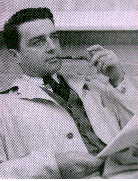 Edwin
Land was born in Bridgeport, Connecticut on 7 May
1909, the son of Matha Goldfaden Land, who had taken
physics at Norwich Academy as a girl, and Harry M.
Land, who had come from Russia to New York as a refugee
when a boy and later became a scrap metal dealer and
real estate owner. Land's older sister, Helen, could
not pronounce Edwin, and said, "Din," instead,
and the nickname stuck. When Din was little, he took
the family's phonograph apart, and his father spanked
him for it. "From then on, I was totally stubborn
about being blocked," the inventor of sheet polarizers
and instant photography later recalled. "Nothing
or nobody could stop me from carrying through the
execution of an experiment."
Edwin
Land was born in Bridgeport, Connecticut on 7 May
1909, the son of Matha Goldfaden Land, who had taken
physics at Norwich Academy as a girl, and Harry M.
Land, who had come from Russia to New York as a refugee
when a boy and later became a scrap metal dealer and
real estate owner. Land's older sister, Helen, could
not pronounce Edwin, and said, "Din," instead,
and the nickname stuck. When Din was little, he took
the family's phonograph apart, and his father spanked
him for it. "From then on, I was totally stubborn
about being blocked," the inventor of sheet polarizers
and instant photography later recalled. "Nothing
or nobody could stop me from carrying through the
execution of an experiment."
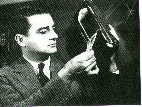 "Our
young people, for the most part -- unless they are
geniuses -- after a very short time in college give
up any hope of being individually great. They plan,
instead, to be good. They plan to be effective. They
plan to do their job. They plan to take their healthy
place in the community. We might say that today it
takes a genius to come out great; and a great man,
a merely great man, cannot survive. It has become
our habit, therefore, to think that the age of greatness
has passed, that the age of the great man is gone;
that this is the day of group research; that this
is the day of community progress. Yet the very essence
of democracy is the absolute faith that while people
must cooperate, the first function of democracy, its
peculiar gift, is to develop each individual into
everything that he might be. But I submit to you that
when in each man the dream of personal greatness dies,
democracy loses the real source of its future strength."
-- MIT, 22 May 1957.
"Our
young people, for the most part -- unless they are
geniuses -- after a very short time in college give
up any hope of being individually great. They plan,
instead, to be good. They plan to be effective. They
plan to do their job. They plan to take their healthy
place in the community. We might say that today it
takes a genius to come out great; and a great man,
a merely great man, cannot survive. It has become
our habit, therefore, to think that the age of greatness
has passed, that the age of the great man is gone;
that this is the day of group research; that this
is the day of community progress. Yet the very essence
of democracy is the absolute faith that while people
must cooperate, the first function of democracy, its
peculiar gift, is to develop each individual into
everything that he might be. But I submit to you that
when in each man the dream of personal greatness dies,
democracy loses the real source of its future strength."
-- MIT, 22 May 1957. 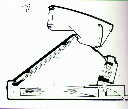
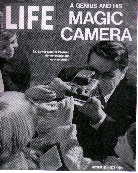 As Polaroid cameras found millions of customers, and
Polaroid became the model high-technology company
as well as Wall Street's darling, Land continued his
career as both a secret and non-secret adviser to
the government. Serving as a technical leader and
bureaucratic deal-maker, he catalyzed the 1954 deal
to build the U-2 spy plane, and long supervised the
building of America's increasingly sophisticated spy
satellites. The U-2 flights showed Soviet efforts
in bombers and missiles to be much more modest than
the Russians boasted. Spy planes and satellites are
credited with reducing America's investments in bombers
and missiles to deter Soviet attacks. For many years,
the photo satellites have been the mainstay of all
the disarmament treaties.
As Polaroid cameras found millions of customers, and
Polaroid became the model high-technology company
as well as Wall Street's darling, Land continued his
career as both a secret and non-secret adviser to
the government. Serving as a technical leader and
bureaucratic deal-maker, he catalyzed the 1954 deal
to build the U-2 spy plane, and long supervised the
building of America's increasingly sophisticated spy
satellites. The U-2 flights showed Soviet efforts
in bombers and missiles to be much more modest than
the Russians boasted. Spy planes and satellites are
credited with reducing America's investments in bombers
and missiles to deter Soviet attacks. For many years,
the photo satellites have been the mainstay of all
the disarmament treaties. 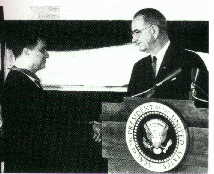 This was no ordinary experimenter: Land founded
two entire industries, pioneered the science-based
industrial enterprise and ran it for more than half
a century, advised presidents on secret overhead reconnaissance
of the Soviet Union, and pushed irrepressibly for
better and better versions of polarizers and instant
films, with the result that his company's sales rose
225-fold in 30 years. The company Land founded was
never for sale, and did not want to acquire other
companies. He was utterly uninterested in me-too products.
He believed in using retained earnings, not debt,
to develop unique systems that the public didn't know
it wanted until they became available. To stay ahead
of the competition, to avoid being swallowed by the
big fish, Land knew that one innovative success created
the imperative to go on to the next.
This was no ordinary experimenter: Land founded
two entire industries, pioneered the science-based
industrial enterprise and ran it for more than half
a century, advised presidents on secret overhead reconnaissance
of the Soviet Union, and pushed irrepressibly for
better and better versions of polarizers and instant
films, with the result that his company's sales rose
225-fold in 30 years. The company Land founded was
never for sale, and did not want to acquire other
companies. He was utterly uninterested in me-too products.
He believed in using retained earnings, not debt,
to develop unique systems that the public didn't know
it wanted until they became available. To stay ahead
of the competition, to avoid being swallowed by the
big fish, Land knew that one innovative success created
the imperative to go on to the next.